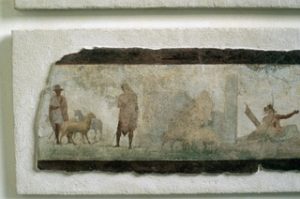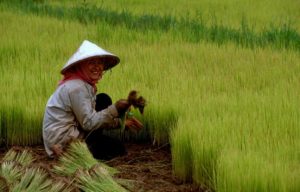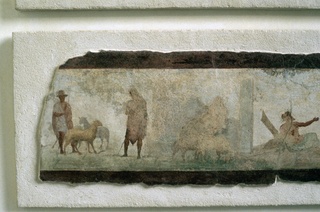Ancient Roman Farming and Crops: Romans used mostly slaves to work in the fields. Slaves were widely available, and they provided cheap labor to work their fields.
Roman Farming and Crops
The fields were plowed with an ard-type plow, which is basically a heavy stick pulled by an ox. Later the Romans did add a colter to the plow, which would help break up the soil before the plowshare would turn the soil over.

Roman farming facts
Grain was harvested by hand until the first century A.D. At this time, the reaping machine called a vallusRoman Farming was invented in Gaul (modern day France) which allowed for an easier harvest.
The wheat would be beaten to separate the chaff (outer covering) from the kernels. The beaten wheat was put into winnowing basket and then tossed into the air.

The lighter chaff would blow away while the heavy grains would fall back to the basket. The Romans also employed a wooden sled known as a Tribulum, which was pulled over the wheat to separate the chaff.
They later imported from North Africa a Punic Cart which used a roller type device to press the grain. After the chaff was removed, the wheat was dried on a drying floor.
Ancient Roman farmers daily life
The wheat was spread on the floor, and a hypocaust, a type of central heating system under the floor, was used. The heating system was similar to that used in the public baths to heat the rooms. The heat dried out the grains, after which they were ready for storage in a granary until it was needed.
Later, the wheat would be ground by large stones. For large amounts of grain, a donkey mill or waterwheel was employed. These would grind large amounts of grain at one time but would also produce coarse flour that would have to be sifted before being used.
Rome needed a large amount of food to supply its large population. Much of this grain was imported from North Africa, especially Egypt. The Romans had to control the Mediterranean Sea to ensure that the needed food supplies were able to flow freely from Africa to Italy.
Roman Crops
Besides wheat, two other primary crops were olives and grapes. Olives were squeezed in special presses for oil. In the Roman Farming and Crops, presses were designed not to crush the seeds which would give the oil a sour taste. Olive oil was used in cooking and also as fuel for lamps. Grapes were pressed either by treading on them or with a screw press to be made into wine.
By 100 B.C. most farming was done on large estates. The owners of these estates often lived in town for the majority of the year. A manager, called a Vilicus, supervised the farm work on the estate.
Another person, the Villisca, would be in charge of the household. Often the Villisca and the Villicus were slaves. The work on the estates was done in large part by slave laborers. Over ninety percent of the Romans lived and worked in the countryside.
More info on- Roman farming tools, animals




